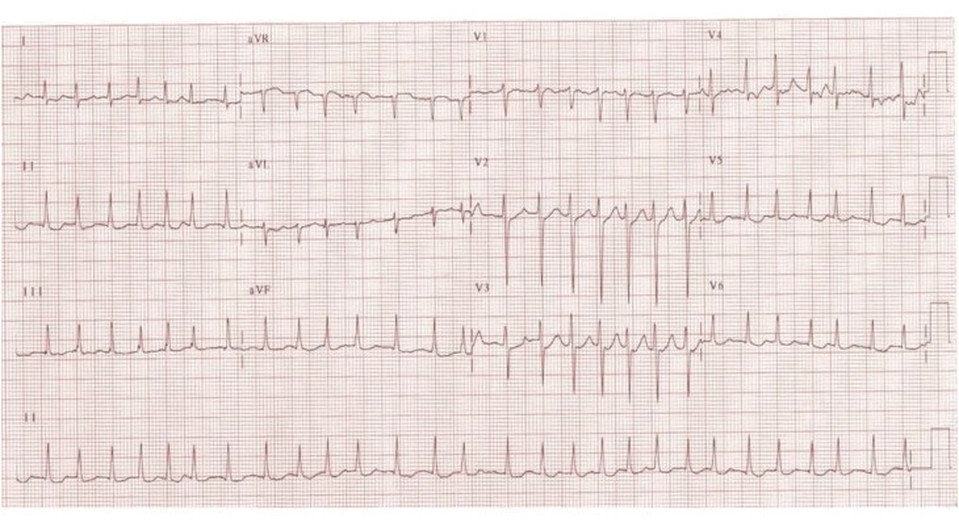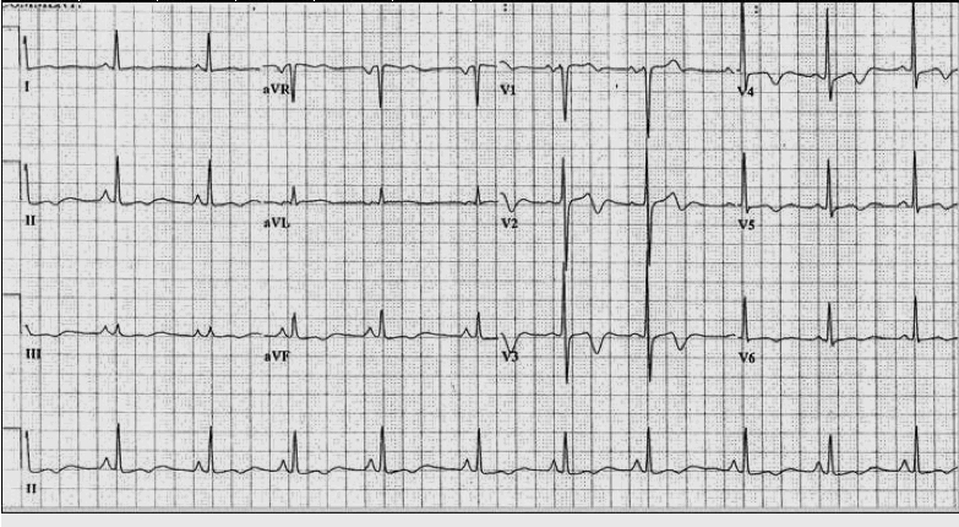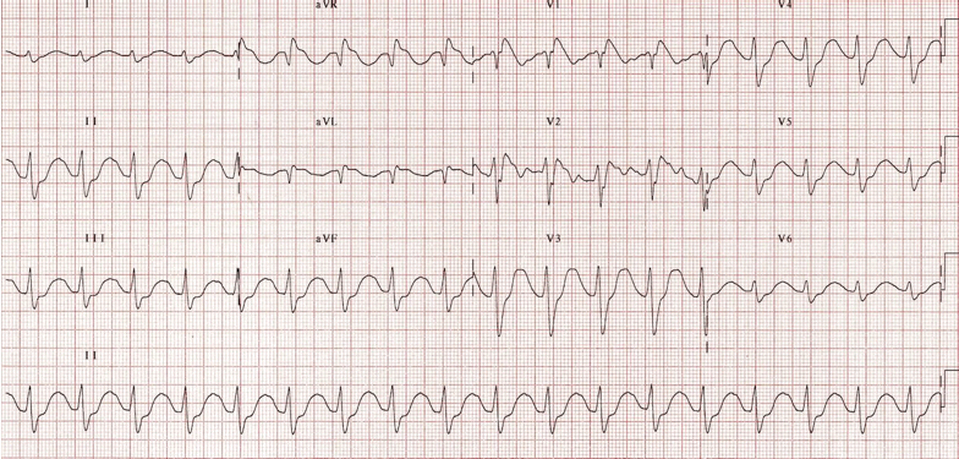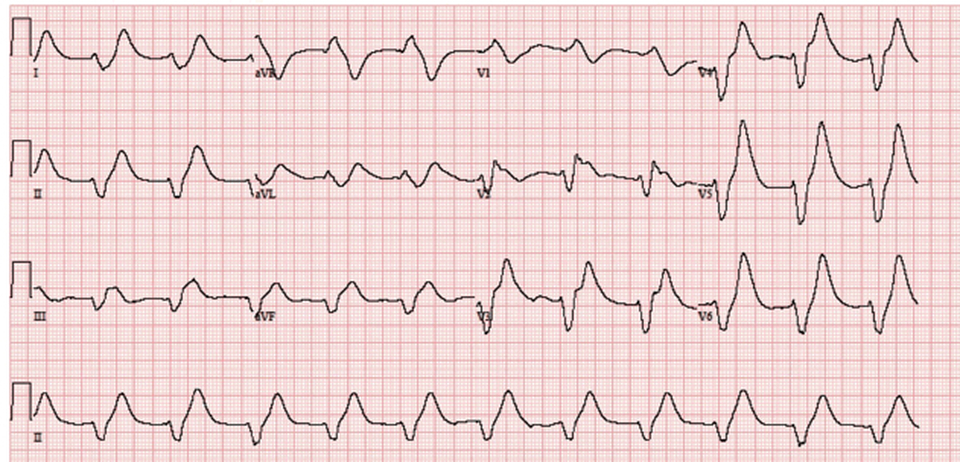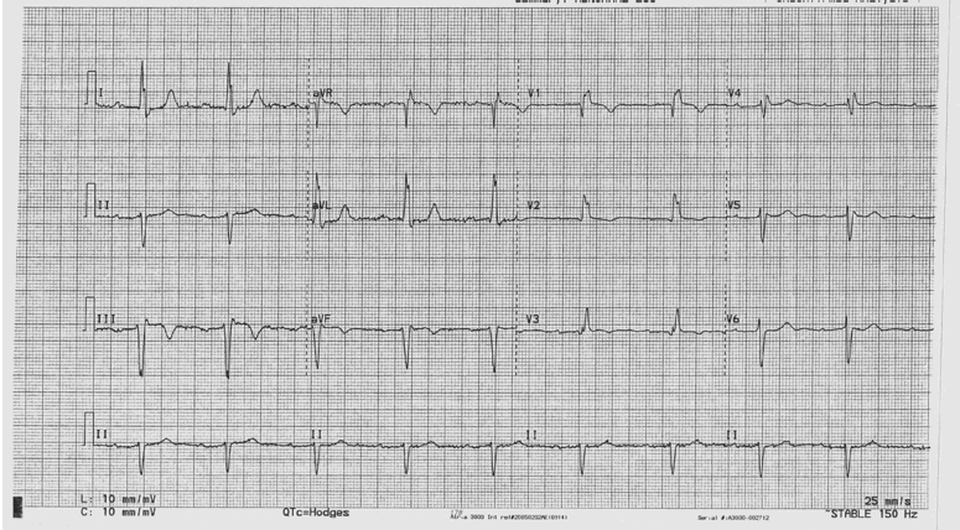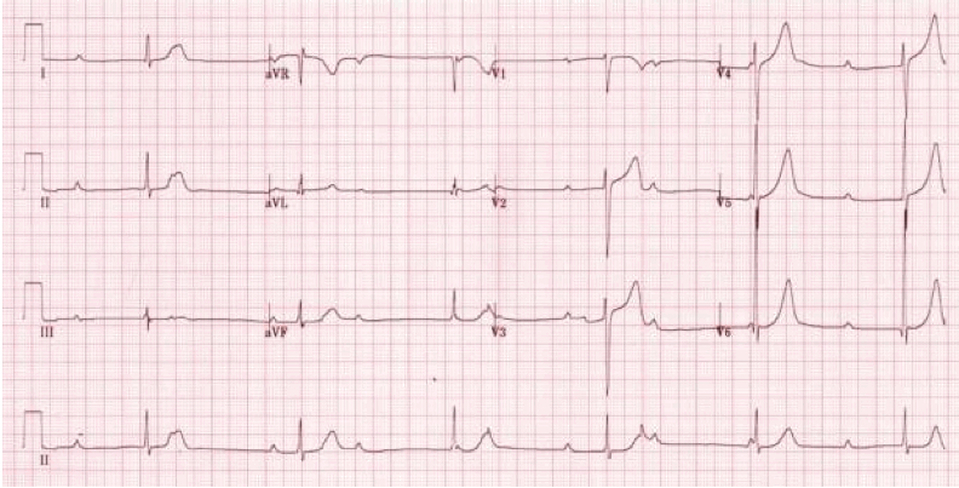MODULE SIX short answer questions.
saq 1.
A 50 year old female presents to your department after a heroin overdose. Her vital signs are:
HR 76 /min
BP 90/62 mmHg
RR 3 /min
O2 sats 2L 96% 2L via prongs
T 37.2 oC
An arterial blood gas is shown below.
FiO2 28%
pH 7.20
pO2 87 mmHg
PCO2 105 mmHg
HCO3- 30 mmol/L
BE +8
Question 1. What are the major acid base disturbances? (3 marks)
Question 2. What is the primary acid-base disturbance? (1 mark)
Question 3. What HCO3- levels would you expect as acute and chronic compensation for the primary disturbance? (2 marks)
Question 4. Is there a V/Q mismatch, or is the primary problem hypoventilation? Why? (4 marks)
HR 76 /min
BP 90/62 mmHg
RR 3 /min
O2 sats 2L 96% 2L via prongs
T 37.2 oC
An arterial blood gas is shown below.
FiO2 28%
pH 7.20
pO2 87 mmHg
PCO2 105 mmHg
HCO3- 30 mmol/L
BE +8
Question 1. What are the major acid base disturbances? (3 marks)
Question 2. What is the primary acid-base disturbance? (1 mark)
Question 3. What HCO3- levels would you expect as acute and chronic compensation for the primary disturbance? (2 marks)
Question 4. Is there a V/Q mismatch, or is the primary problem hypoventilation? Why? (4 marks)
saq 2.
A 21 year old man with a history of insulin dependent diabetes presents to the emergency department with an altered level of consciousness.
His vital signs are:
HR 115 /min
BP 105/73 mmHg
RR 30 /min
O2 sats 2L 99% RA
T 37.3 oC
An arterial blood gas is shown below.
FiO2 21%
pH 7.15
pO2 114 mmHg
PCO2 20 mmHg
HCO3- 8 mmol/L
BE -16
Na+ 140 mmol/L
K+ 6.0 mmol/L
Cl- 110 mmol/L
Question 1. What are the major acid base disturbances? (3 marks)
Question 2. What is the primary disturbance? (1 mark)
Question 3. What CO2 level would you expect as compensation for the primary acid-base disturbance? (1 mark)
Question 4. What is the anion gap? (1 mark)
Question 5. Give 4 acids that are causes of a raised anion gap? (4 marks)
His vital signs are:
HR 115 /min
BP 105/73 mmHg
RR 30 /min
O2 sats 2L 99% RA
T 37.3 oC
An arterial blood gas is shown below.
FiO2 21%
pH 7.15
pO2 114 mmHg
PCO2 20 mmHg
HCO3- 8 mmol/L
BE -16
Na+ 140 mmol/L
K+ 6.0 mmol/L
Cl- 110 mmol/L
Question 1. What are the major acid base disturbances? (3 marks)
Question 2. What is the primary disturbance? (1 mark)
Question 3. What CO2 level would you expect as compensation for the primary acid-base disturbance? (1 mark)
Question 4. What is the anion gap? (1 mark)
Question 5. Give 4 acids that are causes of a raised anion gap? (4 marks)
saq 3.
A 21 year old girl presents complaining of severe chest pain and shaking in the hands. She is acutely distressed, and states that the pain came on after an argument with her boyfriend.
Her vital signs are:
HR 128 /min
BP 109/79 mmHg
RR 38 /min
O2 sats 2L 99% RA
T 37.0 oC
An arterial blood gas is taken by the intern.
FiO2 21%
pH 7.55
PO2 115 mmHg
PCO2 22 mmHg
HCO3- 20 mmol/L
BE +4
Question 1. What are the major acid base disturbances? (3 marks)
Question 2. What is the primary acid-base disturbance? (1 mark)
Question 3. What HCO3- levels would you expect as acute and chronic compensation for the primary disturbance? (2 marks)
Question 4. What is the Aa gradient? (2 marks)
Question 5. What is the likely diagnosis? (2 marks)
Her vital signs are:
HR 128 /min
BP 109/79 mmHg
RR 38 /min
O2 sats 2L 99% RA
T 37.0 oC
An arterial blood gas is taken by the intern.
FiO2 21%
pH 7.55
PO2 115 mmHg
PCO2 22 mmHg
HCO3- 20 mmol/L
BE +4
Question 1. What are the major acid base disturbances? (3 marks)
Question 2. What is the primary acid-base disturbance? (1 mark)
Question 3. What HCO3- levels would you expect as acute and chronic compensation for the primary disturbance? (2 marks)
Question 4. What is the Aa gradient? (2 marks)
Question 5. What is the likely diagnosis? (2 marks)
saq 4.
A 61 year old female presents to your department with a distended abdomen and copious vomiting which has worsened for the past 12 hours. She is complaining of extreme thirst, and has had three vomits since she arrived in your department 45 minutes previously. She has a history of bowel obstructions due to adhesions from previous surgery.
HR 116 /min
BP 115/74 mmHg
RR 8 /min
O2 sats 2L 99% RA
T 37.3 oC
An arterial blood gas is shown below.
FiO2 21%
pH 7.55
pO2 94 mmHg
PCO2 45 mmHg
HCO3- 32 mmol/L
BE +8
Question 1. What are the major acid base disturbances? Indicate the primary derangement. (4 marks)
Question 2. What CO2 levels would you expect as compensation for the primary disturbance? (2 marks)
Question 3. Why does the patient have their acid base disturbance?(1 mark)
Question 4. What further investigations will you order?
HR 116 /min
BP 115/74 mmHg
RR 8 /min
O2 sats 2L 99% RA
T 37.3 oC
An arterial blood gas is shown below.
FiO2 21%
pH 7.55
pO2 94 mmHg
PCO2 45 mmHg
HCO3- 32 mmol/L
BE +8
Question 1. What are the major acid base disturbances? Indicate the primary derangement. (4 marks)
Question 2. What CO2 levels would you expect as compensation for the primary disturbance? (2 marks)
Question 3. Why does the patient have their acid base disturbance?(1 mark)
Question 4. What further investigations will you order?
saq 5.
A 52 year old smoker on home oxygen for COPD present feeling generally unwell. On further questioning he describes a fever and a cough for several days.
His vital signs are:
HR 123 /min
BP 98/71 mmHg
RR 42 /min
O2 sats 2L 89% 6L
T 39.6 oC
An arterial blood gas is taken.
FiO2 40%
pH 7.12
pO2 60 mmHg
PCO2 75 mmHg
HCO3- 16 mmol/L
BE -1
Na+ 145 mmol/L
Cl- 101 mmol/L
Lactate 5.4 mmol/L
Question 1. What are the major acid base disturbances? (4 marks)
Question 2. Which of these is the primary disturbance? (1 mark)
Question 3. What is the anion gap? (1 mark)
Question 4. Is there a metabolic alkalosis present? Justify your answer.
His vital signs are:
HR 123 /min
BP 98/71 mmHg
RR 42 /min
O2 sats 2L 89% 6L
T 39.6 oC
An arterial blood gas is taken.
FiO2 40%
pH 7.12
pO2 60 mmHg
PCO2 75 mmHg
HCO3- 16 mmol/L
BE -1
Na+ 145 mmol/L
Cl- 101 mmol/L
Lactate 5.4 mmol/L
Question 1. What are the major acid base disturbances? (4 marks)
Question 2. Which of these is the primary disturbance? (1 mark)
Question 3. What is the anion gap? (1 mark)
Question 4. Is there a metabolic alkalosis present? Justify your answer.
SAQ 6.
A 79 year old man presents with "palpitations". He has never had them before, and says they began yesterday. He has developed a productive cough and intermittent fevers over the last three days.
His presentation ECG is shown below. Although not specified please assume standard calibration. (25mm/s & 1mV to 10mm)
His presentation ECG is shown below. Although not specified please assume standard calibration. (25mm/s & 1mV to 10mm)
Question 1. What is the rate? (1 mark)
Question 2. Is the rhythm regular or irregular? (1 mark)
Question 3. What is the association of atrial beats to ventricular complexes? (1 mark)
Question 4. Comment on the PR and QT interval. (1 mark)
Question 5. What is the axis? (1 mark)
Question 6. Is there an interventricular conduction defect? Why or why not? (2 marks)
Question 7. Comment on the ST segments. (1 mark)
Question 8. What is the diagnosis? (2 marks)
Question 2. Is the rhythm regular or irregular? (1 mark)
Question 3. What is the association of atrial beats to ventricular complexes? (1 mark)
Question 4. Comment on the PR and QT interval. (1 mark)
Question 5. What is the axis? (1 mark)
Question 6. Is there an interventricular conduction defect? Why or why not? (2 marks)
Question 7. Comment on the ST segments. (1 mark)
Question 8. What is the diagnosis? (2 marks)
saq 7.
A 54 year old man presents with acute central chest pain that occurred while exercising. His pain has now gone away completely. On close questioning he describes a history of exertional dyspnoea and chest discomfort over the prior month.
His ECG on presentation is shown below. Assume standard calibration of the ECG (25mm/s and 10mm to 1mV).
His ECG on presentation is shown below. Assume standard calibration of the ECG (25mm/s and 10mm to 1mV).
Question 1. Give 5 important normal findings on this ECG. (5 marks)
Question 2. What is the major electrocardiographic abnormality? (1 mark)
Question 3. What is the diagnosis? (1 mark)
Question 4. Describe how the results of a troponin will affect your disposition of this patient. (3 marks)
Question 2. What is the major electrocardiographic abnormality? (1 mark)
Question 3. What is the diagnosis? (1 mark)
Question 4. Describe how the results of a troponin will affect your disposition of this patient. (3 marks)
saq 8.
A 26 year old woman is brought to your emergency department after taking an overdose of an unknown susbtance. She has a prior history of depression and multiple overdoses in the past.
Her ECG on arrival is shown below.
Her ECG on arrival is shown below.
Question 1. What are the major abnormalities? (4 marks)
Question 2. Name four drugs from different classes which could cause this ECG and give an example of each. (4 marks)
Question 3. What treatment will you administer as a matter of priority? (2 marks)
Question 2. Name four drugs from different classes which could cause this ECG and give an example of each. (4 marks)
Question 3. What treatment will you administer as a matter of priority? (2 marks)
saq 9.
A 67 year old dialysis patient presents feeling weak and lethargic. He has missed his prior dialysis session because of a migraine.
His ECG on presentation to ED is shown below.
His ECG on presentation to ED is shown below.
Question 1. What are the major abnormalities? (4 marks)
Question 2. What is the likely diagnosis? (1 mark)
Question 3. What treatments will you administer? (5 marks)
Question 2. What is the likely diagnosis? (1 mark)
Question 3. What treatments will you administer? (5 marks)
saq 10.
A 72 year old woman presents to your department with a history of sudden syncope while at church. The nurse looking after her brings you her ECG, which is shown below.
Question 1.
What are the major abnormalities? (5 marks)
Question 2.
What is the diagnosis and its implications? (2 marks)
Question 3.
30 minutes after arrival another ECG is taken as the patient is noted to be unconscious. The ECG is shown below. What are the two major abnormalities and what therefore does the ECG show? (3 marks)Question 3. 30 minutes after arrival another ECG is taken as the patient is noted to be unconscious. The ECG is shown below. What are the two major abnormalities and what therefore does the ECG show? (3 marks)
What are the major abnormalities? (5 marks)
Question 2.
What is the diagnosis and its implications? (2 marks)
Question 3.
30 minutes after arrival another ECG is taken as the patient is noted to be unconscious. The ECG is shown below. What are the two major abnormalities and what therefore does the ECG show? (3 marks)Question 3. 30 minutes after arrival another ECG is taken as the patient is noted to be unconscious. The ECG is shown below. What are the two major abnormalities and what therefore does the ECG show? (3 marks)
